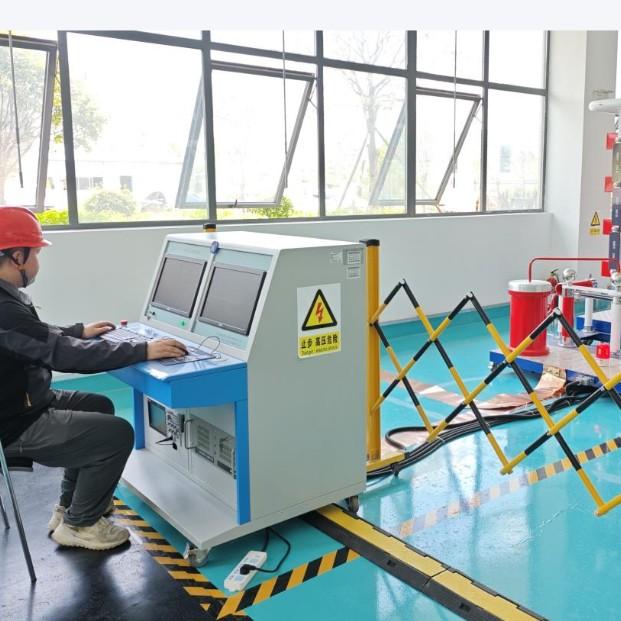1.Shortcomings of Existing Temperature Online Monitoring Products
1.1 Temperature Controller for Dry-Type Transformer Winding Monitoring
Platinum resistance sensors are used in temperature controllers. Since they lack insulation, the sensor must be disconnected from the controller during withstand voltage tests. However, overvoltage during actual operation often damages the controller. Additionally, the sensor's lead wires cannot withstand the 350°C high temperature required for thermal and dynamic stability during secondary-side short circuits of dry-type transformers, frequently resulting in sensor burnout.
1.2 Pressure-Type Resistance Thermometer for Power Transformer Oil Temperature Monitoring
This thermometer uses a platinum resistance sensor. Due to its inherently low resistance value, it is significantly affected by lead wire resistance. Particularly, the contact resistance of multiple terminal connections in the leads changes over time due to oxidation, loosening, or maintenance, and such changes cannot be compensated for in temperature readings. This leads to a common issue of large deviations between displayed and actual oil temperatures, undermining the reliability of temperature readings. Moreover, it lacks multi-point oil temperature monitoring, creating an urgent need for replacement products.
2.Urgently Needed Temperature Online Monitoring for Power Equipment and Specific Locations
2.1 Medium-Voltage Switchgear
Except for older equipment, most medium-voltage switchgear features enclosed structures with anti-misoperation interlocks. During operation, doors or covers blocking infrared radiation cannot be opened for infrared inspections. Internal conductive joints and connectors may experience increased contact resistance due to electrical wear, mechanical operations, and short-circuit electromagnetic forces causing mechanical vibration, leading to temperature rise and accelerated contact surface oxidation, potentially resulting in major equipment failures. The most common fault locations in switchgear are the withdrawable switch contacts and cable connection points at incoming and outgoing lines.
2.2 Medium-Voltage Windings of Dry-Type Transformers
With the development of power equipment, 110kV high-voltage dry-type power transformers and specialized dry-type transformers for railway systems have emerged. Their secondary side is rated at 6–10kV, and some special dry-type transformers have secondary voltages exceeding 660V. Reliable online monitoring products for secondary winding temperatures of these transformers are still lacking.
2.3 Low-Voltage Outlet Terminals of Pole-Mounted Transformers (Distribution Transformers)
Distribution transformers are affected by outdoor environments, and their secondary side often lacks protection, frequently leading to burnout incidents. Statistics show that overheating at the outlet terminals is the primary cause. Article 5.1.4 of the "Power Transformer Operation Regulations" specifies that routine inspections should include checking for signs of heating at lead connections, cables, and busbars. Traditionally, visual inspection, water dripping, or observing oil leakage from bushings are used for judgment. However, due to the large workload of inspections, these checks are often overlooked, causing sudden transformer failures. When the transformer experiences severe three-phase load imbalance, excessive neutral current flows through an undersized neutral outlet terminal. If the connection is poor, it can easily overheat and burn out, damaging numerous household appliances. Therefore, online temperature monitoring at these points is urgently needed.
2.4 Prefabricated Substations (Containerized Substations)
Domestically manufactured prefabricated substations integrate related equipment within fully enclosed enclosures, but most lack integrated design and testing. Due to enclosure—sometimes multiple layers—equipment heat dissipation is affected. Additionally, the extent of equipment derating is difficult to determine reasonably, potentially causing internal equipment to overheat. The State Power Corporation requires in its prefabricated substation tender documents that the operating temperature of all equipment, including transformers and high/low-voltage apparatus, must not exceed their maximum allowable temperatures. This necessitates online temperature monitoring. Currently, prefabricated substations generally only monitor transformer oil temperature and automatically switch on/off ventilation fans based on temperature changes.Due to lack of matching products, temperature monitoring is not implemented as required for transformer outlet terminals, low-voltage switches, and high-voltage switch incoming/outgoing terminals.

3.Two Methods of Online Temperature Monitoring
There are currently two main methods of online temperature monitoring: non-contact infrared radiation and contact-type measurement using thermal sensors. Non-contact infrared sensors are significantly affected by environmental factors such as humidity, atmospheric pressure, and obstructions; if infrared radiation is blocked, accurate measurement becomes impossible, greatly limiting their application. In contrast, contact-type sensors are directly attached to the measurement point, experience less interference from environmental factors, and enable accurate and rapid temperature detection.
Shortcomings of Existing Contact Solutions:
When thermocouples are used as sensors, cold-junction compensation is required because the reference (cold) junction cannot be maintained at 0°C, especially when measuring at room temperature. If the measuring (hot) and reference junctions are far apart, special compensating cables are also needed.
When fiber-optic sensors are used—including a transmitter, receiver, connectors, and optical fiber—the installation and routing of the fiber present significant challenges. Fiber-based signal transmission does not easily achieve complete electrical isolation between high and low potential sides. When the transmitter is installed on the high-voltage side, the problem of insulation to ground remains unresolved.
Using resistive sensors for direct contact measurement with wired signal transmission on the high-potential side, combined with air-gap insulation and infrared-optical conversion to transmit temperature signals, is a viable solution. However, since the infrared emitter and receiver are exposed, dust and contamination accumulate over long-term operation, gradually degrading signal reliability and measurement accuracy—another difficult issue to resolve. Additionally, professional on-site installation and commissioning are required, resulting in suboptimal user convenience.
4.Key Technical Challenges of Online Temperature Monitoring Devices
(1) In low-voltage systems, the main technical challenge is solving the problem of thermal conduction while maintaining electrical insulation for the temperature sensor. In high-voltage systems, it is essential to prevent high voltage from entering the low-voltage side. Since the sensing element is located at the high-voltage end and the monitoring/processing unit is on the low-voltage side, the core technical issue is achieving reliable electrical isolation between the high-voltage and low-voltage systems.
(2) The temperature sensor (including its leads) must meet requirements for stability and heat resistance under high-temperature conditions. It must not only withstand abnormal overheating but also survive the short-term high temperatures generated by dynamic and thermal stress during short-circuit currents without damage.
(3) Accurate temperature measurement requires a method that eliminates the need for compensation, ensuring measurement precision without additional correction.























